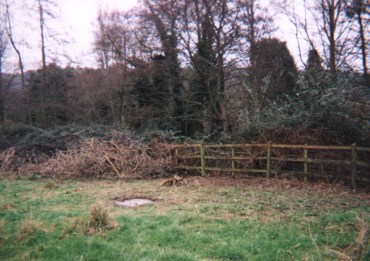

Otters in the UK: how a riverain wildlife habitat in Sidmouth was destroyed by enthusiasts creating a Britain in Bloom memorial.
In line with Environment Agency policies throughout the UK, it has been the aim for several years to see otters and other once common species reintroduced to the rivers Otter and Sid in East Devon. Unfortunately, valuable wildlife habitats have been despoiled as a part of opening up of areas of land to walkers and their dogs.


Clear felling of trees in an area previously frequented by otters and badgers. Thick brambles that had for years provided sanctuary for birds are being cleared and burned as part of 'prettification' and land management (mismanagement). More trees have been planted in a copse in the centre of the field but these will never have the wildlife value of trees close to the river and that were once a part of a secluded and largely undisturbed wildlife sanctuary.
The Otter is a long, slow and meandering river and has many stretches where wildlife survives relatively unmolested by walkers and their dogs and children. In contrast, the river Sid is short, steep and has few stretches which are truly 'away from it all' and therefore suitable as breeding grounds for otters, kingfishers and similar 'shy' species.
Nevertheless, both otters and kingfishers have managed to breed along the Sid - the exact locations are known to only a few local people, some of whom own land adjoining the Sid and who have for years managed it for the benefit of wildlife. One area that (until recently) was relatively undisturbed (and that had supported breeding otters) adjoins what is now known as 'Margaret's Meadow', along the Byes walk from Sidford to Sidmouth. The field is now owned and controlled by the Sid Vale Association, who have a good record overall of wildlife and buildings conservation in the Sid valley.
Margaret's Meadow was purchased and has been comprehensively 'developed' in memory of Margaret Clarke, a stalwart of voluntary service in Sidmouth and who was for many years a town councillor and a Britain in Bloom enthusiast of the old school - all hanging baskets and prettiness and very little apparent knowledge of wildlife conservation.
"Several people have told me that since Margaret's Meadow was developed the wildlife has disappeared" - local naturalist and lifetime resident of East Devon.
In February 2004, a resident of Sidmouth whose land adjoins Margaret's Meadow asked my help to stem the 'development' of the meadow which he claimed was leading to loss of wildlife and intrusion by dogs into what had been tranquil private gardens on the opposite bank of the river. The following letter was published in the Sidmouth Herald on 13/02/04. A reply is awaited. In line with Britain in Bloom policies of ignoring rational argument, it has never be produced!
Protect the Sid's fragile wildlife
MADAM - What is going on in Margaret's Meadow?
Several trees close to the river bank have been felled. Apparently it is planned that the
area becomes a sort of Disneyland with walkways, viewing platforms, noise, and
(inevitably) scattered plastic waste and bins for doggy detritus. Until recently, the area
was home to rare wildlife.
It might be helpful to restate basic principles of wildlife management along rivers.
Unavoidably, there are stretches of the Sid where people and their activities will
continue to dominate. From Lymebourne to the sea, and around the bridge at Sidford, no
self respecting otter or kingfisher would make its home. All that we can hope for (and
occasionally see) at Sidford is a flash of blue on a summer's day as a frightened creature
flies from one area of sanctuary to another. In these 'sterilised' zones therefore,
residents and visitors are able occasionally to see rare wildlife whilst being unable to
provide directly for its continued existence.
It is another matter on what are (or were) the few long and largely undisturbed stretches
of the Sid. Here kingfishers breed - and maybe otters too according to your article of 6
Feb that reported loss of fish from garden ponds. Those of us in the know keep the
locations to ourselves lest the ignorant, misbehaved or malcontented with their dogs,
camcorders or rampaging children ruin everything.
Now reflect on the stated aims of the Sid Vale Association as displayed at the entrance to
the Gilchrist Field along the Byes. "Do nothing to disturb the wildlife, walk dogs on
a lead (obviously most dog owners cannot read), take only photographs, leave only
footprints" Quite admirable, so why along one of the least disturbed areas of the Sid
have long stretches of footpath been located tantalisingly close to the river and is an
area now being clear felled exactly where it should either be left alone or fenced off?
In the simplest terms, the few remaining long stretches of the Sid that are presently
'undisturbed' should be protected to provide the best possible chance for fragile and
threatened species to breed in peace. Granted that 'Britain in Bloom' played a part in
Margaret Clarke's distinguished life but the emphasis now of even this organisation is
changing towards long term conservation.
Yours sincerely
DR STEPHEN J WOZNIAK
back to top of gardening section OR back to top of Sidmouth section